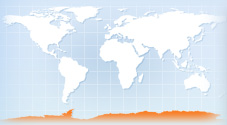Global warming threatens the world's largest ice cube

Antarctica has always been a land of surprises, dating back to its discovery and confirmation as a continent in the first half of the 1800s. But the impacts global warming is bringing to the world’s largest continent are not welcome surprises.
In the spring of 2002, scientists were shocked to discover that an ice shelf the size of Rhode Island had disintegrated in just over a month from the West Antarctica ice sheet. The collapse of the Larsen B ice shelf was a wake up call to scientists who had thought that these large areas of ice would take a millennium to disappear, not a month.
Antarctica is covered by two ice sheets. The larger East Antarctic ice sheet covers the majority of the continent, while the West Antarctic ice sheet has significant ice shelves floating in the ocean. Taken together, they contain 90 percent of Earth's ice and 70 percent of its freshwater and would raise sea level over 200 feet if they completely melted.
Because the floating ice of the West Antarctic is subject to both warming air and ocean temperatures, scientists think it is especially vulnerable to global warming. Until recently, it was believed that only coastal areas of the West Antarctic were vulnerable to melting. But satellite analysis has revealed that large inland regions are also showing signs of the impacts of warming. NASA and university researches have found clear evidence that an area the size of California melted in January 2005 in response to warm temperatures.
But ice isn’t the only thing on the decline in Antarctica. Many species of penguins have declined 50 percent over the past 50 years in Antarctica. The U.S. Fish and Wildlife Service is currently evaluating 10 species of penguins for listing under the Endangered Species Act. Warming temperatures and melting ice are reducing penguin habitat and food sources. Krill, the food at the core of many penguins’ diets, feed on algae that live under sea ice. As sea ice melts, the amount of algae declines and the krill population declines with it. Krill stocks are down 80 percent since the 1970s by some estimates.



